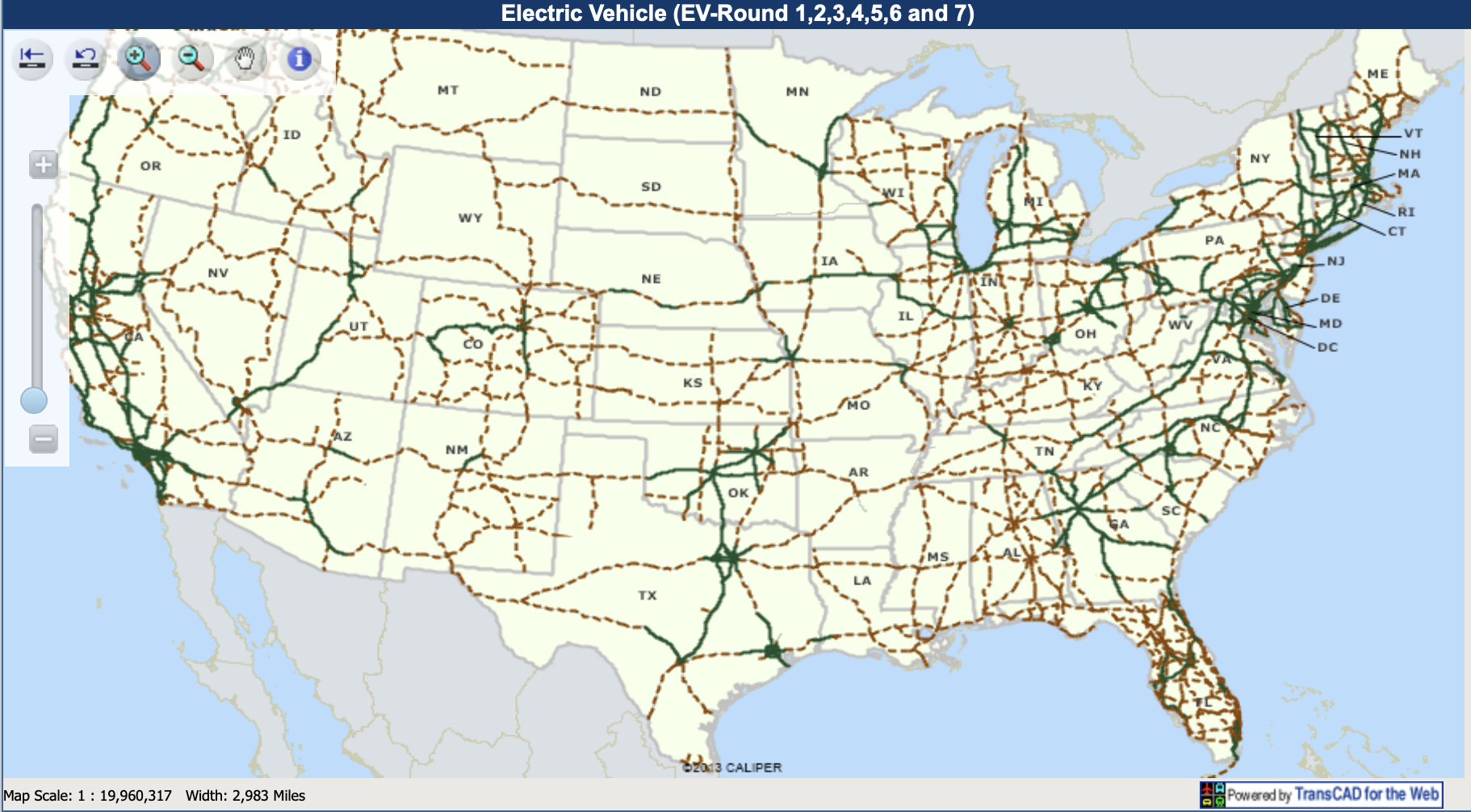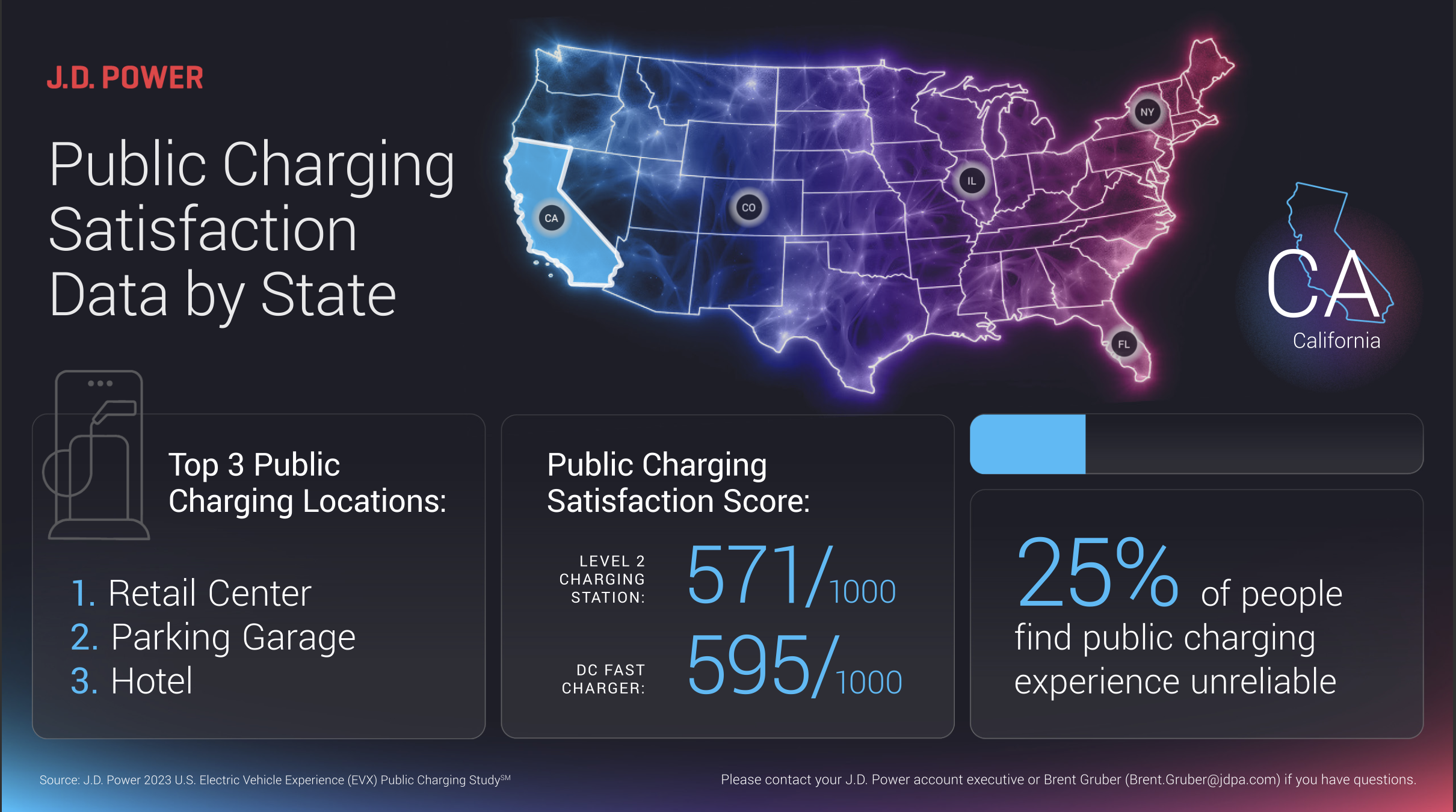Six solutions to fix public EV charging. Time is short as 100% ZEV mandates emerge.
Electric vehicle charging is not always reliable, forcing federal and state governments, automakers, and charging providers to implement new solutions. The goal? Boost EV adoption.
EV drivers face range anxiety from faulty public chargers.
In August, JD Power issued its annual EV charging report on consumer satisfaction. The results were not good. Since last year, consumer happiness with public chargers fell by 2.5% for standard chargers and 3.0% for DC fast chargers. Overall, one in five attempts “end[ed] without charging, the majority of which [were] due to station outages.” One bright spot is that JD Power found Tesla achieved the highest consumer satisfaction rating across the industry for its fast charger network.
A 2022 research paper came to the same conclusion, finding that “22.7% of [public chargers] were non-functioning [due to] unresponsive or unavailable screens, payment system failures, charge initiation failures, network failures, or broken connectors.” A disturbing assessment of the EV charging industry.
The fear of being stranded with a dead battery, especially along an interstate highway or remote countryside, discourages average consumers from switching to EVs. Drivers do not want to be stranded without power.
On a brutally hot day in Los Angeles I pulled into a grocery store parking lot to use a DC fast charging station. I had just driven from San Francisco and I was down to 30 miles in my Hyundai Ioniq 5 electric vehicle (EV). I tried earlier during my drive to charge at a station, but four out of the six kiosks were not functioning and the two that were working were taken. So I decided to risk arriving with only 10% of my battery left.
I joined two other EV drivers trying to charge, both of whom were on the phone with customer service. My heart sank because after several attempts the charge would not initiate. - Susannah Saunders, California Energy Commission Docket Number: 22-EVI-04
Six solutions to end electric-vehicle range anxiety
Policymakers, the auto industry, and technology providers acknowledge that reliability and uptime must be improved to encourage consumers to switch away from fossil-fuel cars and trucks.
Fixing charging problems is even more urgent in the sixteen states with 100% zero-emission mandates. These mandates, patterned after California’s rules, require all new vehicle sales in 2035 to meet zero emissions (see below). Consumers will rebel against these mandates if they cannot get a satisfactory charging experience.
Here are six actions underway to create a reliable, fast, easy-to-use national charging experience for consumers.
1. Build out a unified national network every 50 miles.
Under the Bipartisan Infrastructure Law (BIL) signed by President Biden two years ago, the federal government has set a goal for “a nationwide network of 500,000 EV chargers by 2030 that ensures a convenient, affordable, reliable, and equitable charging experience for all users”.
Source: Alternate Fuel Corridor (AFC) electric vehicle charger build-out. Solid Green = Ready (meets 50-mile requirement between chargers) and Dotted Orange = Pending.
To achieve this goal, the National Electric Vehicle Infrastructure (NEVI) Program provides up to $5 billion to build the national charging network along interstate highways, designated as the Alternate Fuel Corridor (AFC). The AFC chargers must be installed no more than 50 miles apart and no more than one mile from the highway corridor. Once the interstate network is completed, states may use their remaining funds for local EV charger projects.
The funds for each state started flowing in 2002, with $615 million disbursed. The final fund distribution, estimated at $855 million, will be sent to the states in 2026. Five states will receive one-third of the total funds to build their EV charging network: Texas, California, Florida, New York, and Pennsylvania. The states must follow Federal Highway Administration regulations to assure conformity to national goals and performance standards (see solution 2).
States may also apply for an additional $100 million to repair or replace existing non-functioning chargers.
2. Mandate charging performance.
To achieve a universal, reliable charging experience across all states and vehicle manufacturers, the National Electric Vehicle Infrastructure (NEVI) Standards and Requirements mandate:
97% minimum uptime. “States or other direct recipients must ensure that each charging port has an average annual uptime of greater than 97%” [§ 680.116 (b)]. The uptime is calculated by a formula that accounts for out-of-service events beyond the control of the charging system. Such uncontrollable events include vandalism, electric utility service interruptions, natural disasters, and scheduled maintenance. The NEVI regulations have not yet set penalties for non-compliance.
24/7 EV charging availability. “Charging stations located along and designed to serve users of designated Alternative Fuel Corridors [AFC] must be available for use and sited at locations physically accessible to the public twenty-four hours per day, seven days per week, year-round” [§ 680.106 (e)]. EV Chargers located away from the AFC may adjust their operating hours to match the business operating hours of the host site.
Payment ease of use. Unless an EV charger is permanently cost-free, EV chargers must “[p]rovide for secure payment methods, accessible to persons with disabilities, which at a minimum shall include a contactless payment method that accepts major debit and credit cards, and either an automated toll-free phone number or a short message/messaging system (SMS) that provides the EV charging customer with the option to initiate a charging session and submit payment” [§ 680.106 (f)].
Charger outage reporting. “States or other direct recipients must ensure that EV charging customers have mechanisms to report outages, malfunctions, and other issues with charging infrastructure” [§ 680.106 (k)].
Qualified maintenance technicians. “States or other direct recipients shall ensure that the workforce installing, maintaining, and operating chargers have appropriate licenses, certifications, and training to ensure that the installation and maintenance of chargers is performed safely by a qualified and increasingly diverse workforce of licensed technicians and other laborers” [§ 680.106 (j)]”
Interoperability across EV charger networks and charger ports. The NEVI requires manufacturers of EV chargers and network operators to conform to the latest international communication protocols so that the user experience is seamless across all funded charges and the vehicle mapping and software systems used to identify available chargers for drivers. The three protocols are:
“Open Charge Point Interface (OCPI 2.2.1) means an open-source communication protocol that governs the communication among multiple charging networks, other communication networks, and software applications to provide information and services for EV drivers” [§ 680.104 Definitions].
“Open Charge Point Protocol (OCPP 2.0.1) means an open-source communication protocol that governs the communication between chargers and the charging networks that remotely manage the chargers” [§ 680.104 Definitions].
“Plug and Charge (ISO-15118-2) means a method of initiating charging, whereby an EV charging customer plugs a connector into their vehicle and their identity is authenticated through digital certificates defined by ISO-15118, a charging session initiates, and a payment is transacted automatically, without any other customer actions required at the point of use” [§ 680.104 Definitions].
Quarterly record keeping and reporting. NEVI requires quarterly data collection on charge port performance “for ongoing monitoring and analysis of use and reliability.” Quarterly data collected includes:
Charger identifier and port identifier;
Charging session start time, end time, and any error codes;
Energy (kWh) dispensed to EVs per charging session by port;
Peak session power (kW) by port;
Payment method associated with each charging session; and
Charging station port uptime, outage time, and excluded time.
3. Create and test technology standards.
While NEVI provides high-level mandates of a 97% uptime charging experience across the US, industry participants must develop and test new products meeting the requirements.
To accelerate the coordination of best practices across the industry to meet the 97% uptime requirement, the Joint Office of Energy and Transportation has launched the National Charging Experience Consortium (ChargeX Consortium).
This Consortium is led by the US Department of Energy national laboratories: Argonne National Laboratory, Idaho National Laboratory, and the National Renewable Energy Laboratory. Twenty-nine organizations have joined ChargeX, including car manufacturers General Motors, Ford, Stellantis, Rivian, and Tesla, and EV charger providers AmpUp, Electrify America, EVgo, and Plug-in America.
ChargeX will create three working groups to address the growth of a reliable, unified national network by addressing:
Payment processing and user interface.
Vehicle-charger communication
Diagnostic data sharing.
The Consortium will evaluate current practices, develop new solutions, and test the solutions for a rapid, seamless rollout to the industry by June 2025.
4. Standardize the charging plug.
Multiple charging plugs for different car manufacturers and charging levels (slow and fast) are nonsensical for growing the electric vehicle industry. Starting with Ford, the auto industry has settled on the Tesla charger design, now the North American Charging Standard (NACS).
In addition to Ford, most major car companies, including GM, Nissan, Toyota, BMW, Subaru, Volvo, Honda, and Hyundai, are adopting NACS. In addition, EV charging companies such as ChargePoint, EVgo, Electrify America, and Blink are also redesigning their products for the NACS charging standard.
Importantly, SAE International, the engineering standards-setting organization for the auto industry, plans to release a NACS standard, referred to as J3400, by the end of 2023. This standard will enable the “Plug & Charge” capability experienced by Tesla owners. Tesla owners plug their cars into the charger and walk away without any complex payment or initiation process requiring their mobile phones. The charger software handles charging notifications and payments without user actions.
5. Legislate state actions to improve charging.
The path to California’s 100% Zero Emission Vehicles (ZEV) and Plug-in Hybrid Electric Vehicles (PHEV). Source: California Air Resources Board
California is the leading state for clean air regulations and electric vehicle ownership, driving changes in other states. For example:
Fifteen other states use EPA’s California clean air waivers. California’s clean air regulations trigger zero-emission vehicle rules in fifteen other states under Section 177 of the Clean Air Act (42 USC §7507). Therefore, California’s Advanced Clean Cars II Regulations requiring 100% zero-emission vehicle sales for all new passenger cars, trucks, and SUVs by 2035 apply to fifteen other states.
37% of all EV cars are registered in California. California is also important to the EV industry because it leads the states with electric vehicle registrations, totaling 903,600 EVs registered in 2002, or 37% of all EV vehicles in the US. The closest two states are Florida and Texas, with 7% and 6% of total US EV sales, respectively. Cumulatively, 1.6 million EVs have been sold in California since 2011. No other state is even close. The California New Cars Dealership Association publishes California’s quarterly and annual registrations of electric vehicles.
Because of the 2035 ZEV sales mandate, the California legislature wants to fix consumer dissatisfaction with charging. In a recent JD Power survey, 25% of California’s EV users found public charging unreliable.
To consider solutions, the legislature seeks to gather data on all California-funded EV chargers. In 2022, California legislators passed Assembly Bill (AB) 2061 requiring the California Energy Commission (CEC) to work with the Public Utility Commission (PUC) to “develop uptime recordkeeping and reporting standards for electric vehicle chargers and charging stations by January 1, 2024”. These NEVI-compatible regulations apply to chargers funded by state agencies and utilities.
Given this legislative mandate, the CEC proposed new regulations in Docket 22-EVI-04, “Electric Vehicle Charging Infrastructure Reliability. The draft regulations are described in a CEC staff report and presentation. Automakers, EV charger manufacturers, network providers, and consumers are now filing comments on the proposed rules.
With the spotlight on charging reliability, EV charging manufacturers and network providers will be forced by public pressure, legislation, or future penalties to achieve 97% uptime and 97% minimum payment success rate as proposed by the CEC.
6. Manufacture faster-charging cars and chargers.
Automakers and charging companies are beginning to compete on charging speed.
The voltage to boost charging speed is increasing from Tesla chargers at 250 KW to the new ChargePoint Express Plus Power Link at 400 KW. The new ChargePoint units will be rolled out to 400 Mercedes-Benz sites with 2500 new charging units. These chargers will be compatible with the new NACS standard. Expect more charger manufacturers to distinguish themselves on their charging speed as reliability improves across all industry sectors.
But faster chargers are not enough. The cars must be able to use higher voltage to boost speed. Edmunds has rated 43 car models on their charging speed. The top ten models are shown below, with Hyundai and Kia leading the pack. The Hyundai Ioniq 6 rear-wheel drive will take 217 miles of charge in just 15 minutes.
Source: Edmunds EV Charging Test: How fast does each EV charge? Updated November 15, 2023, for 43 vehicle models
Now that EV charging is improving, I expect competition will provide consumers with more choices than just relieving range anxiety. Consumers will shop and compare EVs on price, features, and brand values. Currently, Tesla leads the EV auto industry, as shown in California registrations, but that could change with greater charging speed and reliability from other manufacturers.
Source: California New Cars Dealership Association and Cleantech Adoption.
This post was also published on https://cleantechadoption.substack.com.






